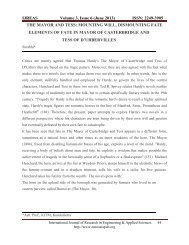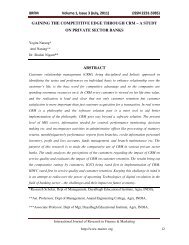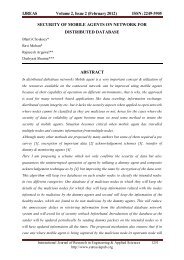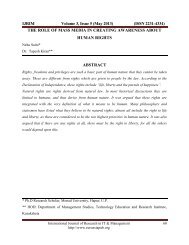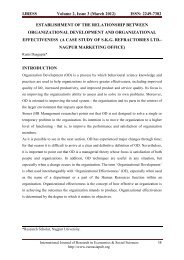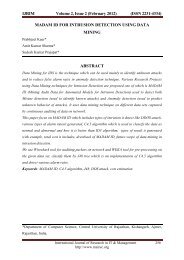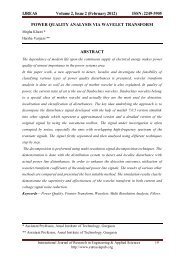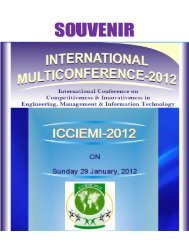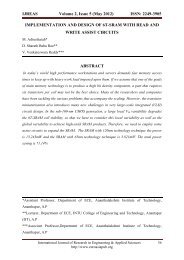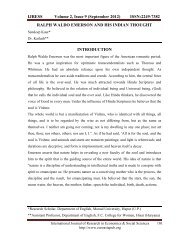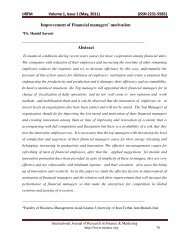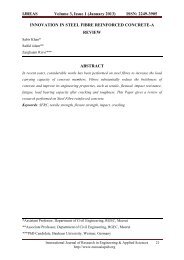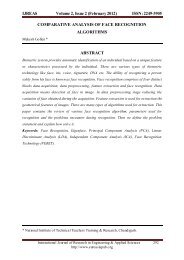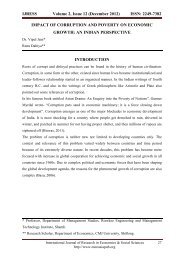A RELATIONSHIP BETWEEN ORGANISATIONAL ... - Euroasiapub.org
A RELATIONSHIP BETWEEN ORGANISATIONAL ... - Euroasiapub.org
A RELATIONSHIP BETWEEN ORGANISATIONAL ... - Euroasiapub.org
You also want an ePaper? Increase the reach of your titles
YUMPU automatically turns print PDFs into web optimized ePapers that Google loves.
IJRFM Volume 1, Issue 2 (June, 2011) (ISSN 2231-5985)<br />
A <strong>RELATIONSHIP</strong> <strong>BETWEEN</strong> <strong>ORGANISATIONAL</strong> CULTURE AND<br />
INDUSTRIAL RELATIONS ENVIRONMENT IN A CHANGING<br />
SCENARIO: A CASE STUDY ON ROURKELA STEEL PLANT,<br />
ODISHA<br />
Nibedita Nanda*<br />
Ipseeta Nanda**<br />
Abstract<br />
Indian industries today are saddled with a culture in the work place and in society in general,<br />
which is not conducive to hard work and competition. Over the years the work culture in our<br />
country has degenerated. Some of the most common manifestations of degeneration are the<br />
presence of intense labour management. Culture represents a shared perception of reality<br />
through which <strong>org</strong>anization members assign meaning to various activities undertaken by<br />
<strong>org</strong>anization. Organization culture can be defined as a pattern of basic assumptions invested,<br />
discovered or developed by a given group as it learns to cope with its problems of external<br />
adaption and internal integration that has worked well enough to be considered valuable and<br />
therefore to be taught to new members as the correct way to perceive, think and full in<br />
relation to those problems. Since <strong>org</strong>anizational culture is represented at various levels such<br />
behaviours and antifacts constituting the observable units/dimensions, beliefs, attitudes and<br />
values manifested in patterns of response and assumptions that are often beyond the level of<br />
conciseness. It affects the fundamental choices <strong>org</strong>anizations make in defining and relating to<br />
the environment. Industrial Relation means the <strong>org</strong>anization and practice of multi-pronged<br />
relationships between workers and management, unions and workers, and the unions and<br />
management in an industry. The main purpose of this study is to identify the dimensions of<br />
responsive work culture for gaining and maintaining competitive edge as also articulate the<br />
emergent roles of various actors, particularly the management and trade unions.<br />
*Dept. of HR, DAMITS, Rourkela, Orissa, India<br />
**Dept. of ETC, Silicon Institute of Technolgy, Sambalpur, Orissa, India<br />
International Journal of Research in Finance & Marketing 47<br />
http://www.mairec <strong>org</strong>
IJRFM Volume 1, Issue 2 (June, 2011) (ISSN 2231-5985)<br />
The study aims at examining the relationship between the Industrial Relations environment<br />
and <strong>org</strong>anizational culture in selected <strong>org</strong>anization. The study shall examine the extent to<br />
which the existing Organizational culture has an influence on the Industrial Relations<br />
environment.<br />
Keywords: - Indian Relation, Industrial Relation Environment, Organizational Culture,<br />
Trade Union,<br />
INTRODUCTION<br />
The people who work together for the accomplishment of some common objectives require a<br />
definite structure through which they relate to each other and through which their effort can<br />
be coordinated in to a team. Such a structure is called <strong>org</strong>anization.<br />
Basically, <strong>org</strong>anizational culture is the personality of the <strong>org</strong>anization. Culture is comprised<br />
of the assumptions, values, norms and tangible signs of <strong>org</strong>anization members and their<br />
behaviours. Members of an <strong>org</strong>anization soon come to sense the particular culture of an<br />
<strong>org</strong>anization. Culture is one of those terms that are difficult to express distinctly, but<br />
everyone knows it when they sense it.<br />
According to Allen <strong>org</strong>anizing is the process of identifying and grouping the work to be<br />
performed, defining and delegating responsibility and authority and establishing relationship<br />
for the purpose of enabling the people to work most effectively together in accomplishing<br />
objectives.<br />
Today’s laser-fast age calls for multifaceted development of Indian <strong>org</strong>anizations to achieve<br />
excellence and attain global standards through effective cost management, quality control,<br />
high speed delivery of services and customer orientation. Through the new economic reforms<br />
policy, attempts have been made dismantling of controls and regulations to strengthen the<br />
competitive power of Indian industry necessitating thereby technology up gradation,<br />
productive and quality improvement. Changes in these parameters have necessitated changes<br />
in the work environment and management practices.<br />
With newer technologies overtaking industry and affecting changes in every sphere of<br />
human life, the social profile of the work force as underwent a vast change. At the present<br />
age it demands to generate a work force which is more qualify, highly skilled and willing to<br />
work .Thus the workers today are to be young, educated and more skilled than the workers in<br />
the older industries. The needs, aspirations and the value orientations of the workers have<br />
changed drastically from fulfilling primary needs of job security, better wages and working<br />
International Journal of Research in Finance & Marketing 48<br />
http://www.mairec <strong>org</strong>
IJRFM Volume 1, Issue 2 (June, 2011) (ISSN 2231-5985)<br />
conditions to valuing the intrinsic qualities of work such as challenge, meaning in work,<br />
autonomy, ability to use once own discretion in the job etc (Sen Gupta, 1981).To get the best<br />
out of these people, Boyett and Conn (1992) emphasized that <strong>org</strong>anizations need to create a<br />
unique culture. As industries progress towards becoming more knowledge oriented,<br />
knowledge, skill or intellectual capital is increasingly becoming firm’s main source of added<br />
value and the basis of a sustainable competitive advantage. Increasingly tightened<br />
competition, today, therefore implies that regardless of the country or economic condition in<br />
which they operate, <strong>org</strong>anizations are under tremendous pressure to develop their human<br />
resource in order to sustain competitive advantage in the knowledge based economy.<br />
Organizational culture is the set of assumption that the members of an <strong>org</strong>anization share in<br />
common. Such assumption may be in the form of internally oriented characteristics like<br />
believe, values, attitudes, feelings, personality types and so on known as abstract element of<br />
the culture or externally oriented characteristic like products, buildings and dresses etc.<br />
known as element of the culture. Vijay Sathe has exemplified some common things to<br />
demonstrate the components <strong>org</strong>anizational culture:<br />
• Shared things(e.g. the way people dress)<br />
• Shared saying(e.g. let’s go down to work)<br />
• Shared action(e.g. a service oriented approach)<br />
• Shared feelings(e.g. hard work is rewarded here)<br />
Every <strong>org</strong>anization, being a social entity, develops within it a cultural system with some<br />
unique modes distinguish one <strong>org</strong>anization from other.<br />
It is the need of the hour to infuse a high performance culture in industrial <strong>org</strong>anization and<br />
such an <strong>org</strong>anization culture can be characterized by some important features are as follows:<br />
• A leadership that empowers others<br />
• Borderless sharing of power<br />
• Values of accountability, transparency and belongingness<br />
• High level of trust<br />
• Personal responsibility<br />
• High employee and employer involvement and commitment<br />
• Open sharing of relevant information<br />
• Partnering<br />
International Journal of Research in Finance & Marketing 49<br />
http://www.mairec <strong>org</strong>
IJRFM Volume 1, Issue 2 (June, 2011) (ISSN 2231-5985)<br />
There has been a fundamental shift in paradigm in the world of knowledge, which has<br />
affected the basic way of thinking conceptualizing and operating on complexities of change<br />
in the environment. The new paradigm <strong>org</strong>anizations will have the characteristics:<br />
• Joint optimization of technical, human and ecological system<br />
• Self-managing groups with joint/shared responsibility<br />
• Control and coordination through shared norms<br />
• Optimal task grouping and multiple broad skills<br />
• Design based on minimum critical specifications<br />
• Variety increasing: option generating continuous learning<br />
• Adaptation through adjustment and learning<br />
• Simultaneous/ concurrent operation and activities<br />
• Decentralized self-content units with internal suppliers and customers; companies within<br />
company<br />
• Manager as an entrepreneur, work group as a small business<br />
IMPORTANCE OF <strong>ORGANISATIONAL</strong> CULTURE<br />
Organizational culture is shaped by the management philosophy and practices, and has<br />
profound impact on the way employees approach problems, serve customers and related to<br />
the environment. Organizational culture has directive, potency, regulatory, uncertainty<br />
reduction and consummator functions. In view of these multiple functions that <strong>org</strong>anizational<br />
culture performs, it often becomes a substitute to the formal network of structure, rules and<br />
procedures prevailing in an <strong>org</strong>anizations leading to widening of the gap between espoused<br />
theory and theory in use in most <strong>org</strong>anizations. Continuity in culture is maintained through<br />
selective transmission of cultural elements from one generation to another.<br />
Since <strong>org</strong>anizational culture is represented at various levels such as behaviours and artefacts<br />
constituting the observable units/dimensions; beliefs, attitudes and values manifested in<br />
patterns of response and assumptions that are often beyond the level of consciousness; it<br />
affects the fundamental choices <strong>org</strong>anizations make in defining and relating to the<br />
environment.<br />
Organizations are also tending to evolve sub-cultures depending on formal and informal<br />
group formation, ethnic affiliation and task demands. For the group within the <strong>org</strong>anization,<br />
culture may provide a common purpose and facilitate co-ordination of activities.<br />
International Journal of Research in Finance & Marketing 50<br />
http://www.mairec <strong>org</strong>
IJRFM Volume 1, Issue 2 (June, 2011) (ISSN 2231-5985)<br />
Organizational membership is guided by culture, how the boundaries are maintained, who is<br />
an insider and who is an outsider. Thus recruitment and selection can be major culture<br />
enhancement or change mechanisms, especially when applied to key positions in the<br />
<strong>org</strong>anization.<br />
Culture also performs a social function. It provides a medium in which friendships can<br />
develop. It provides an opportunity for the development of identity and sense of belonging.<br />
The predictability of such social environment provides for security.<br />
Culture influences what the executive group attends to, how it interprets the information and<br />
the responses it makes to changes in the external environment. It is a significant contributor<br />
to strategic analysis and the development of strategy. Since culture influences what other<br />
members of the <strong>org</strong>anization attend to, how they interpret this information and react, it is a<br />
significant determinant of the success of strategic implementation.<br />
The decisions that are made in an <strong>org</strong>anization, the goals and standards that are sought and<br />
the pattern and manner of behaviour are affected by culture.<br />
Dependent upon the degree of fit between <strong>org</strong>anizational demands and personal beliefs,<br />
attitudes and values, it results in commitment and feelings of satisfaction or antagonism,<br />
dissatisfaction, anxiety and stress.<br />
SIGNIFICANCE OF CULTU<br />
The study of culture acquires significance as it has an enabling and reinforcing impact on:<br />
Continuity of the social system or the collectivity through the process of transmission,<br />
socialization and revitalization of ideas norms and behaviour. It establishes and differentiates<br />
the human group from other groups that tend to develop core culture and sub-cultures.<br />
Culture makes predictability of responses possible by establishing common codes of conduct,<br />
standards, norms, symbols and distinguishing between desirable and undesirable behaviour.<br />
Thought, feeling and action are integrated by building consistency of thought, developing<br />
socially desirable way of expressing feelings and action. Through prioritization of goals,<br />
developing societal value system, the responses increase intensity thereby increasing the<br />
potency of human need,.<br />
It provides regulatory mechanisms including self-regulation by inculcating in the human<br />
collectivity the feeling of guilt, shame, fear of social disapproval, humiliation etc. It<br />
facilitates development of normative orientation through creation of shared value systems<br />
International Journal of Research in Finance & Marketing 51<br />
http://www.mairec <strong>org</strong>
IJRFM Volume 1, Issue 2 (June, 2011) (ISSN 2231-5985)<br />
creating and developing shared norms, values boundaries. Above all members derive<br />
satisfaction and a sense of pride in responding to and meeting the needs of the given culture.<br />
The capacity of human collectivity to be responsive to increased uncertainty and<br />
discontinuous changes in the environment is limited because they threaten the basic fabric of<br />
the existing culture by challenging its continuity, creating the for redefining its identity and<br />
necessitating re-examination, restatement and prioritization of value orientation, normative<br />
frame work and ethical standards. Culture thus becomes a major factor hindering the adoptive<br />
coping capabilities of social systems. The rise and fall of civilizations throughout human<br />
history can be explained in terms of initiative or lack of it, taken by human collectivities in<br />
pro-actively resolving the inner contradictions amongst various dimensions of culture,<br />
necessitated by fundamental shifts in contextual scenarios. Formal <strong>org</strong>anizations of all types<br />
encounter the same dilemma in situations of perpetual change in their environments. The<br />
growth or decline of these <strong>org</strong>anizations can be attributed to the prevailing corporate culture<br />
which is design to ensure continuity, stability, predictability, internal and external integration<br />
and the like thus making the task of realignment and adjustment difficult.<br />
INDUSTRIAL RELATIONS<br />
Industrial Relations in its traditional connotation involves active interaction amongst various<br />
actors- employer, employees and the government aimed at maintaining industrial harmony<br />
and contributing to enhanced effectiveness of industrial enterprises. Healthy relationship<br />
amongst the employer, employees and the government is essential for protecting their interest<br />
representing the larger society. A positive industrial relations environment characterized by<br />
congenial relationship between management and the workmen based on mutual trust,<br />
collaborative orientation and joint problem solving and decision making is a prerequisite for<br />
not only industrial peace but also for improved effectiveness and sustained growth of the<br />
<strong>org</strong>anization. In its wider connotation, Industrial Relation means the <strong>org</strong>anization and<br />
practice of multi-pronged relationships between workers and management, unions and<br />
workers, and the unions and management in an industry. Dale Yoder defines it as a, “whole<br />
field of relationship that exists because of the necessary collaboration of men and women in<br />
the employment process of an industry”.<br />
According to Tead and Metcalfe Industrial Relations are the composite result of the attitudes<br />
and approaches of employers and employees towards each other with regard to planning,<br />
supervision, direction and co-ordination of the activities of an <strong>org</strong>anization with minimum of<br />
International Journal of Research in Finance & Marketing 52<br />
http://www.mairec <strong>org</strong>
IJRFM Volume 1, Issue 2 (June, 2011) (ISSN 2231-5985)<br />
human efforts and friction’s with an animating spirit of co-operation and with proper regard<br />
for the genuine well-being of all members of the <strong>org</strong>anization.<br />
The Encyclopaedia Britannica explains that,” The concept Industrial Relations has been<br />
extended to denote the relations of the State with employers, workers and their <strong>org</strong>anizations.<br />
The subject, therefore, includes individual relations and joint consultation between employers<br />
and workers at their work place, collective relations between employers and their<br />
<strong>org</strong>anizations and trade unions and part played by the State in regulating these relations”.<br />
Industrial Relation is thus, the relation created at different levels of the <strong>org</strong>anization by the<br />
diverse, complex and composite needs and aspirations and attitudes and approaches among<br />
the participants. It is a highly complex and dynamic process of relationship involving not<br />
only employees and management’s, but also their collective forums and the State. In an<br />
<strong>org</strong>anization, these relationships may be personal and informal at one end, and may be highly<br />
institutional with legally prescribed structures and procedures at the other end.<br />
RESPONSIVE <strong>ORGANISATIONAL</strong> CULTURE & INDUSTRIAL<br />
RELATIONS IN THE CHANGING SCENARIO<br />
The changes in international economic order and geo-political environment in wake of the<br />
breaking of the Berlin wall, transition in Central and East European countries and the end of<br />
cold-war, changes in macro-economic and social environment, technological and structural<br />
changes, worker profile (Sengupta, 1992) call for fresh perspectives on our thinking, our<br />
beliefs, our philosophy, our value system connecting the management of people at workplace<br />
and elsewhere. The dynamic change process warrants a fresh look at the institutional and<br />
legal frame work and also the roles of the principal actors (Venkatratnam, 1996). The labour<br />
management relations in India has been characterize by predominance of adversarialism, the<br />
general lack of mutual trust and understanding, communication gap and win-lose orientation.<br />
India’s IR systems and practices have much room for improvement more especially in the<br />
context of strengthening competitiveness and efficiency of Indian industries to facilitate their<br />
integration with global economy (Guha, 1994).<br />
Issues relating to structural flexibility, multi-skilling, continuous learning, shared norms will<br />
have to be incorporated in the main agenda of Industrial Relations. Trade unions are as much<br />
affected by the emergent paradigm as the management. The emergence of new breed of<br />
knowledge workers, their changed profile will necessitate the trade unions to broaden their<br />
scope of operations, democratize their processes and be flexible enough to meet their<br />
International Journal of Research in Finance & Marketing 53<br />
http://www.mairec <strong>org</strong>
IJRFM Volume 1, Issue 2 (June, 2011) (ISSN 2231-5985)<br />
professional competency requirements and carrier growth aspirations. The declining<br />
importance of job security and increased mobility of the workers have created problems of<br />
retention of workforce, the management should therefore re-orient its policies and develop<br />
multidimensional reward systems to retain them and provide them job satisfaction.<br />
Attainment of global standards and survival of Indian <strong>org</strong>anizations in this highly competitive<br />
borderless global economic order calls for the joint endeavour of all the stake holders-the<br />
government, the employers, the workers and their unions. Organizational re-structuring, the<br />
changing patterns of labour management relations, nature of employment, the sharing of<br />
gains and social accountability have exerted pressure on the tripartite social patterns to<br />
redefine their roles and relationships in order to promote a new industrial culture. It demands<br />
that employers and workers take a hard look at their practices and attitudes and f<strong>org</strong>e a<br />
common front to bring about modernization and technological change, strengthen discipline,<br />
improve productivity and share equitably the fruits of growth. The Government as the<br />
statutory and regulatory authority should in the changed context, focus increasingly on the<br />
needs that labour laws and regulations are meant to fulfil and introduced modifications in<br />
existing laws or regulations relating to issues such as security of employment and<br />
employment conditions in the wake of privatization, closure of sick industries and labour<br />
displacements caused by modernization and related development which would help foster<br />
more harmonious labour management relations.<br />
In the years since liberalizations, of the Indian economy perhaps the most significant<br />
development has been the accelerating pace of change across all sectors of the economy. The<br />
impact of such change is so widely felt that few <strong>org</strong>anizations or sectors have been left<br />
untouched. In both private sector and public sector companies have been affected by the<br />
globalization of competition by dramatically shortening production and development cycles,<br />
by quantum leaps in technology and frantic intensification of competition. The impact of<br />
change has driven many <strong>org</strong>anizations to re-think and re-visit issues of <strong>org</strong>anizational culture.<br />
Culture change is likely to become more rather than less, significant over the decades.<br />
Increasingly though <strong>org</strong>anizations will have to treat such change, not as a one of discrete<br />
phenomena, but as continuing process, which constantly reviews, refines and improves the<br />
<strong>org</strong>anization’s overall capacity respond to external development. Designing, developing and<br />
sustaining appropriate work culture of excellence will thus become a major issue to concern<br />
for most <strong>org</strong>anizations seeking to gain and maintain competitive edge in the globally<br />
competitive environment.<br />
International Journal of Research in Finance & Marketing 54<br />
http://www.mairec <strong>org</strong>
IJRFM Volume 1, Issue 2 (June, 2011) (ISSN 2231-5985)<br />
The present study aims at identifying significant dimensions of responsive work culture<br />
conducive to achieving global standards of performance specifying contributions of<br />
management and workers to that end and examining their implications for Industrial<br />
Relations and practices in Indian <strong>org</strong>anizations.<br />
INDUSTRIAL RELATIONS ENVIRONMENT AND WORK CULTURE<br />
It is evident that without a work culture of excellence the <strong>org</strong>anizations in India will not be<br />
able to develop, healthy Industrial Relations a pre-requisite to providing competitive edge in<br />
global market place. There is inevitably interactive relationship between Industrial Relations<br />
and Work Culture.<br />
The structural adjustment policy adopted by India and its struggle to gain competitive edge<br />
in the global economic order envisages a strong commitment and change in the outlook<br />
thinking and attitude of its people. Attitude change presupposes change in work culture. It<br />
has been increasingly realized that human resource is the most important resource for any<br />
economy to thrive and prosper. India fortunately has skilled and competent manpower and<br />
the cost of manpower is low as compared to many other industrially developed countries.<br />
Responsive work culture is reflected in continuous improvement in productivity, quality,<br />
innovation and growth; legitimate areas of concern for both management and labour. In India<br />
work has been accorded a secret place in the scriptures. However, over the years there has<br />
been an erosion of the values and it is often argued that Indian worker today lacks a positive<br />
work culture. The worker more often is blamed for this (Sodhi, 1998). The workers, on the<br />
other hand, blame the management for its high-handedness, on healthy practices and hostile<br />
attitude towards labour. Attitudinal change is thus imperative to enable <strong>org</strong>anizations to adapt<br />
to the competitive environment, which can come about only gradually through sustain cooperation<br />
and concerted efforts among the three social partners-the Government, the<br />
employers and the employees.<br />
Every <strong>org</strong>anization develops a culture unique to its own, which can be termed as<br />
<strong>org</strong>anizational ideology-patterns of beliefs, values, norms, rituals, myths and sentiments<br />
shared by the members of <strong>org</strong>anization. The ideology, which is implicit in the minds of<br />
employees, influences and governs the response patterns of individuals and groups within the<br />
<strong>org</strong>anization. It thus regulates the energy exchange between the <strong>org</strong>anization and its members<br />
and impacts most aspects of <strong>org</strong>anizational life, such as how decisions are made, who makes<br />
International Journal of Research in Finance & Marketing 55<br />
http://www.mairec <strong>org</strong>
IJRFM Volume 1, Issue 2 (June, 2011) (ISSN 2231-5985)<br />
them, how rewards are distributed, who is promoted, how people are treated, how the<br />
<strong>org</strong>anization responds to its environment and so on.<br />
The concept of <strong>org</strong>anization ideology was first suggested by Roger Harrison as a significant<br />
area of study enabling <strong>org</strong>anization to diagnose their cultural state and design interventions<br />
for developing a desired culture of excellence.<br />
Four <strong>org</strong>anization ideologies or culture orientation have been identified: Power, Role,<br />
Achievement/Task and Support. Although <strong>org</strong>anizations tend to have the presence of<br />
characteristics of all the four cultural orientations, based on the individual and collective<br />
paradigm, through time they develop a dominant ideology. A brief description of the<br />
characteristics of four ideologies/cultural orientations can be stated as follows<br />
• Power oriented <strong>org</strong>anizations can be compared with cob webs wherein all <strong>org</strong>anizational<br />
processes and individual energies are directed towards maintaining and strengthening the<br />
power position of a central figure which could be an individual or a group. Large<br />
<strong>org</strong>anizations tend to develop several power centers.<br />
• Role Orientated culture tends to share some of the characteristics of what is commonly<br />
called bureaucracy .The arbitrary use personal and resource based power of an<br />
individual/group is regulated by delegation of legitimate authority at various levels in the<br />
<strong>org</strong>anization .Specified role is delineated for <strong>org</strong>anization members and their responsibility<br />
and authority defined. Systems, rules and procedures are developed for judicious use of<br />
one’s authority, performance of one’s role and discharging of one’s responsibility as a<br />
result of which functional differentiations takes place often leading to compartmentalization<br />
and problems of co-ordination and controlled. The role oriented culture reinforces stability<br />
and maintenance of the system.<br />
• While Power and Role oriented cultures tend to rely more on extrinsic rewards for<br />
directing the energies and efforts of employees towards growth of the <strong>org</strong>anization, the<br />
task/achievement oriented culture focuses on intrinsic rewards for generating commitment<br />
amongst employees towards task accomplishment and <strong>org</strong>anizational excellence.<br />
Organization structure and processes are designed to facilitate task performance, which is<br />
the requirement of various tasks that determined the allocation of responsibility and<br />
distribution of authority.<br />
• The support culture is driven by the growth related needs of the individuals thereby<br />
unleashing and harnessing the human potential in meeting their expectations and<br />
International Journal of Research in Finance & Marketing 56<br />
http://www.mairec <strong>org</strong>
IJRFM Volume 1, Issue 2 (June, 2011) (ISSN 2231-5985)<br />
aspirations. Employees thus are treated with dignity and respect and recognize inherent<br />
goodness of man.<br />
METHODOLOGY<br />
The instrument Diagnosing Organization Culture developed and published by Roger<br />
Harrison and Herb Stokes was administered to the managerial staff of Rourkela Steel Plant to<br />
diagnose the <strong>org</strong>anization culture. The study was based on convenience sampling method;<br />
nearly 220 questionnaires were distributed to the employees of the <strong>org</strong>anization, of which 150<br />
were received bac<br />
The questionnaires consists 15 sections, each sections includes four statements relating to<br />
the four cultural orientations. Respondents were asked those four statements first in terms of<br />
what they considered to be existing view in the <strong>org</strong>anization and then rank the same<br />
statements in terms of their personal preference. The questionnaires thus provided two<br />
separate ranking of their four cultural types: power, role, achievement and support.<br />
Respondents’ perception of the <strong>org</strong>anization prevailing culture was obtained by adding the<br />
rank assigned to each of the fifteen items characterizing a particular culture orientation. The<br />
cultural profiles were developed by dividing both the respondents ranking of existing and<br />
preferred cultural orientations in to two categories: most preferred and least preferred. The<br />
cultural orientation ranked as first or second was described as least preferred and those<br />
ranked third and fourth were most preferred.<br />
The predominant cultural orientation in Rourkela Steel Plant, as perceived by the<br />
<strong>org</strong>anization members however, is power orientation followed by Role Orientation. The<br />
Achievement and Support orientation get third and fourth respectively. In Rourkela Steel<br />
Plant however the most preferred cultural orientation is Achievement followed by Support.<br />
The least preferred orientation is Power followed by Role.<br />
In the following pages responses against each dimension have been analyzed and depicted<br />
with the help of tables and bar graphs for each <strong>org</strong>anization. The bar graph for each<br />
dimension reflects the total number of response given by the respondents in absolute numbers<br />
given to each of the four cultural orientations- power, role task and support for existing and<br />
preferred. The two tables (a) and (b) indicate the frequency of response in percentage for the<br />
existing ideology or the way things are in the <strong>org</strong>anization and preferred ideology or the way<br />
things should be in the <strong>org</strong>anization.<br />
1. Desirable Behavior<br />
International Journal of Research in Finance & Marketing 57<br />
http://www.mairec <strong>org</strong>
IJRFM Volume 1, Issue 2 (June, 2011) (ISSN 2231-5985)<br />
Employees tend to direct their behavior towards what is expected of them by the<br />
<strong>org</strong>anization. The expectation of the <strong>org</strong>anization plays an important role in shaping the<br />
behavior patterns of the employees.<br />
Existing Ideology<br />
Most<br />
Domina P R A S<br />
nt 59 34 34 0<br />
24 48 10 17<br />
Least 10 14 41 38<br />
Domina<br />
nt 7 3 45 45<br />
Preferred Ideology<br />
Most<br />
Domina P R A S<br />
nt 17 14 66 6.9<br />
7 24 17 52<br />
Least 16 40 14 28<br />
Domina<br />
nt 60 22 34 14<br />
Table 1(a)<br />
Table 1(b)<br />
Desirable Behaviour<br />
Frequency of response in percentage N=58<br />
Desirable Behavior<br />
60<br />
50<br />
Employees<br />
40<br />
30<br />
20<br />
10<br />
Existing Ideology<br />
Preferred Ideology<br />
0<br />
P R A S<br />
Behavior<br />
In RSP 89% of the respondents feel that the <strong>org</strong>anization expects them to meet the needs and<br />
demands of high level people in the <strong>org</strong>anization and those who are in position of power.<br />
As their personal preference,66% of the respondents feel that the employees should be<br />
expected to meet the challenges of the task and find better ways of doing their work.<br />
International Journal of Research in Finance & Marketing 58<br />
http://www.mairec <strong>org</strong>
IJRFM Volume 1, Issue 2 (June, 2011) (ISSN 2231-5985)<br />
2. Criteria for Reward<br />
Reward systems, both monetary and psychological are directed towards re-enforcing<br />
desirable responses of the employees. Employees therefore adopt those behaviors that are<br />
likely to be rewarded by the <strong>org</strong>anization.<br />
Preferred Ideology<br />
Most<br />
Domina P R A S<br />
nt 10 3 69 17<br />
7 7 17 66<br />
Least 14 69 7 14<br />
Domina<br />
nt 69 21 7 3<br />
Existing Ideology<br />
Most<br />
Domina P R A S<br />
nt 69 14 14 3<br />
10 59 17 14<br />
Least 10 17 53 19<br />
Domina<br />
nt 10 10 16 64<br />
Table 2(a)<br />
Criteria for Reward<br />
Frequency of response in percentage<br />
N=58<br />
Table 2(b)<br />
Criteria for Reward<br />
Employees<br />
80<br />
70<br />
60<br />
50<br />
40<br />
30<br />
20<br />
10<br />
0<br />
P R A S<br />
Reward<br />
Existing Ideology<br />
Preferred Ideology<br />
Whereas in Rourkela Steel Plant 69% of the respondents feel that those people who<br />
know how to please their superiors and are able and willing to use power and politics to get<br />
ahead are able to do well in the <strong>org</strong>anization, which gets the lowest priority in their personal<br />
preference.<br />
3. Decision-making<br />
The way decisions are made does not only affect the quality of outcome but also morale of<br />
the employees.<br />
International Journal of Research in Finance & Marketing 59<br />
http://www.mairec <strong>org</strong>
IJRFM Volume 1, Issue 2 (June, 2011) (ISSN 2231-5985)<br />
Existing Ideology<br />
Most<br />
Domina P R A S<br />
nt 59 17 14 7<br />
21 59 14 14<br />
3 24 53 19<br />
Least<br />
Domina<br />
nt 17 0 19 60<br />
Table3(a)<br />
Preferred Ideology<br />
Most<br />
Domina P R A S<br />
nt 10 9 36 38<br />
10 38 36 19<br />
10 43 14 36<br />
Least<br />
Domina<br />
nt 69 10 14 7<br />
Table 3(b)<br />
Decision Making<br />
Frequency of response in percentage N=58<br />
DECISION-MAKING<br />
E m p lo y e e s<br />
70<br />
60<br />
50<br />
40<br />
30<br />
20<br />
10<br />
0<br />
P R A S<br />
Decision<br />
Existing Ideology<br />
Preferred Ideology<br />
59% in Rourkela Steel Plant feel that the directives, orders and instructions come from<br />
the higher levels. 38% in Rourkela Steel Plant feel that the most desirable way of<br />
decision-making should be through consensus to gain acceptance and support for<br />
decisions and to enhance decision quality.<br />
4. Task Allocation<br />
Performance of the employees, their morale and the amount of personal satisfaction they<br />
derive from their respective job is predominantly determined by the assignment of tasks<br />
or job allocation.<br />
International Journal of Research in Finance & Marketing 60<br />
http://www.mairec <strong>org</strong>
IJRFM Volume 1, Issue 2 (June, 2011) (ISSN 2231-5985)<br />
Existing Ideology<br />
Most<br />
Dominan P R A S<br />
t<br />
66 17 7 0<br />
17 52 14 17<br />
Least 10 17 57 22<br />
Dominan<br />
t<br />
7 14 22 60<br />
Table 4(a)<br />
Preferred Ideology<br />
Most<br />
Domina P R A S<br />
nt 10 21 64 16<br />
17 26 26 31<br />
17 40 3 36<br />
Least<br />
Domina<br />
nt 55 14 7 17<br />
Table 4(b)<br />
Task Allocation<br />
Frequency of response in percentage N=58<br />
Task Allocation<br />
60<br />
50<br />
Employees<br />
40<br />
30<br />
20<br />
Existing Ideology<br />
Preferred Ideology<br />
10<br />
0<br />
P R A S<br />
Task<br />
While expressing their preferences too 83% in Rourkela Steel Plant and 64% in Rourkela<br />
Steel Plant have made the same choice that assignment of jobs should match the<br />
requirements of the job with the interests and abilities of the individuals.<br />
5. Work Motivation<br />
In Rourkela Steel Plant employees’ motivation to perform well and achieve excellence is<br />
governed and influenced by the prevailing ideology in the <strong>org</strong>anization.<br />
International Journal of Research in Finance & Marketing 61<br />
http://www.mairec <strong>org</strong>
IJRFM Volume 1, Issue 2 (June, 2011) (ISSN 2231-5985)<br />
Preferred Ideology<br />
Most<br />
Domina P R A S<br />
nt 07 07 72 03<br />
09 24 10 64<br />
17 57 10 22<br />
Least<br />
Domina<br />
nt 67 12 07 10<br />
Table 5(a)<br />
Existing Ideology<br />
Most<br />
Domina P R A S<br />
nt 48 28 17 07<br />
31 40 19 14<br />
Least 07 16 47 31<br />
Domina<br />
nt 14 17 17 48<br />
Table 5(b)<br />
Work Motivation<br />
Frequency of response in percentage N = 58<br />
Work Motivation<br />
Employees<br />
80<br />
70<br />
60<br />
50<br />
40<br />
30<br />
20<br />
10<br />
0<br />
P R A S<br />
Achieve<br />
Existing Ideology<br />
Preferred Ideology<br />
In Rourkela Steel Plant 48% of the respondents feel that hope for rewards, fear of<br />
punishment, or personal loyalty to the supervisor are the primary reasons for work motivation<br />
in their <strong>org</strong>anizations. While 72% feel that strong desires to achieve, to create and to innovate<br />
and peer pressure to contribute to the success of the <strong>org</strong>anizations should be the primary<br />
reasons for work motivations.<br />
CONCLUSION<br />
The results of the study provided empirical support for scholar’s argument that <strong>org</strong>anizational<br />
cultures affect how an <strong>org</strong>anization practices industrial relations. It also provides a starting<br />
point toward the development of a valid and reliable measurement for employee<br />
communication. The work culture prevalent in an <strong>org</strong>anization plays a decisive role not only<br />
International Journal of Research in Finance & Marketing 62<br />
http://www.mairec <strong>org</strong>
IJRFM Volume 1, Issue 2 (June, 2011) (ISSN 2231-5985)<br />
in interpretation of given environment, choice of strategic direction, technology options but<br />
also in providing direction and determining intensity of responses of employees to meeting<br />
the challenges of the internal environment and contextual constituents. Findings suggest that<br />
when change is seen as a positive characteristic of the environment, employees are more<br />
likely to commit to the work of the institution.<br />
REFERENCES<br />
[1]Allen, R. (1985): Four Phases for Bringing About Cultural Change; Oxford<br />
[2]Bate, S. (1994): Strategies for Cultural Change; Butterworth Heinemann, Oxford<br />
[3]Benedict, R. (1934): Patterns of Culture; Houghton Mifflin, Boston<br />
[4]Brown, A. (1995): Organisational Culture; Pitman Publishing, London<br />
[5]Budd, John W. and Bhave, Devasheesh (2008) "Values, Ideologies, and Frames of<br />
Reference in Industrial Relations," inSage Handbook of Industrial Relations, Sage.<br />
[6]Befort, Stephen F. and Budd, John W. (2009) Invisible Hands, Invisible Objectives:<br />
Bringing Workplace Law and Public Policy Into Focus, Stanford University Press.<br />
[7]Budd, John W. and Bhave, Devasheesh (2010) "The Employment Relationship," in Sage<br />
Handbook of Handbook of Human Resource Management, Sage<br />
[8]De Silva, S. (1995): Harmonizing Industrial Relations and Human Resource<br />
Management; International Labour Organisations Journal, 12, 3, 45<br />
[9]Dessler, G (2001): Management, leading people and <strong>org</strong>anisations in the 21st century;<br />
Prentice Hall Inc, New Jersey.<br />
[10]Fox, Alan (1974) Beyond Contract: Work, Power and Trust Relations, Farber and Farber.<br />
[11]Kilmann, M. et al (1986): Gaining Control of the Corporate Culture; McGraw Hill<br />
[12]Kaufman, Bruce E. (2004) Theoretical Perspectives on Work and the Employment<br />
[13]Leat, M (2001): Exploring employee relations; Heinemann, Butterworth, Oxford<br />
Relationship, Industrial Relations Research Association.<br />
[14]Niland, J., Russell, L. and Verevis, C. (1994): The Future of Industrial Relations; Sage<br />
Publications, p 466<br />
[15]Purcell, J. (1987): Mapping management styles in employee relations; Journal of<br />
Management Studies, 24, 5, 535–48<br />
[16]Vroom, V. (1964). Work and motivation.<br />
International Journal of Research in Finance & Marketing 63<br />
http://www.mairec <strong>org</strong>



